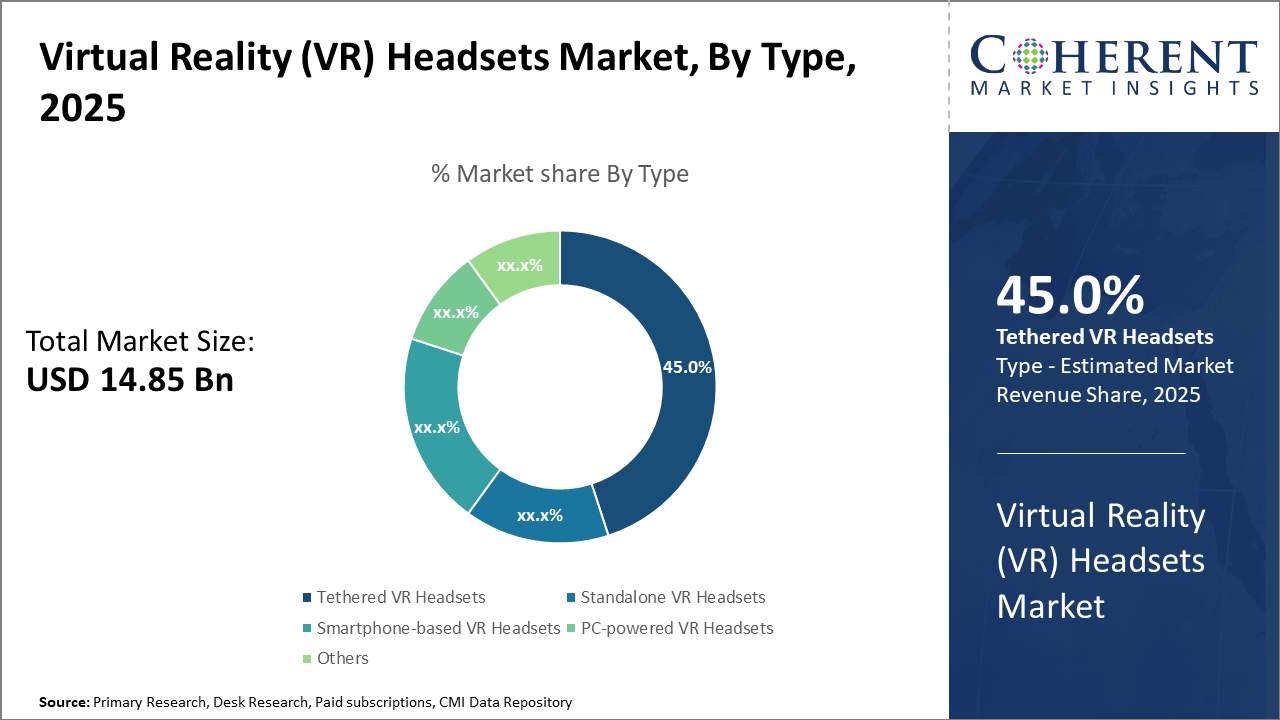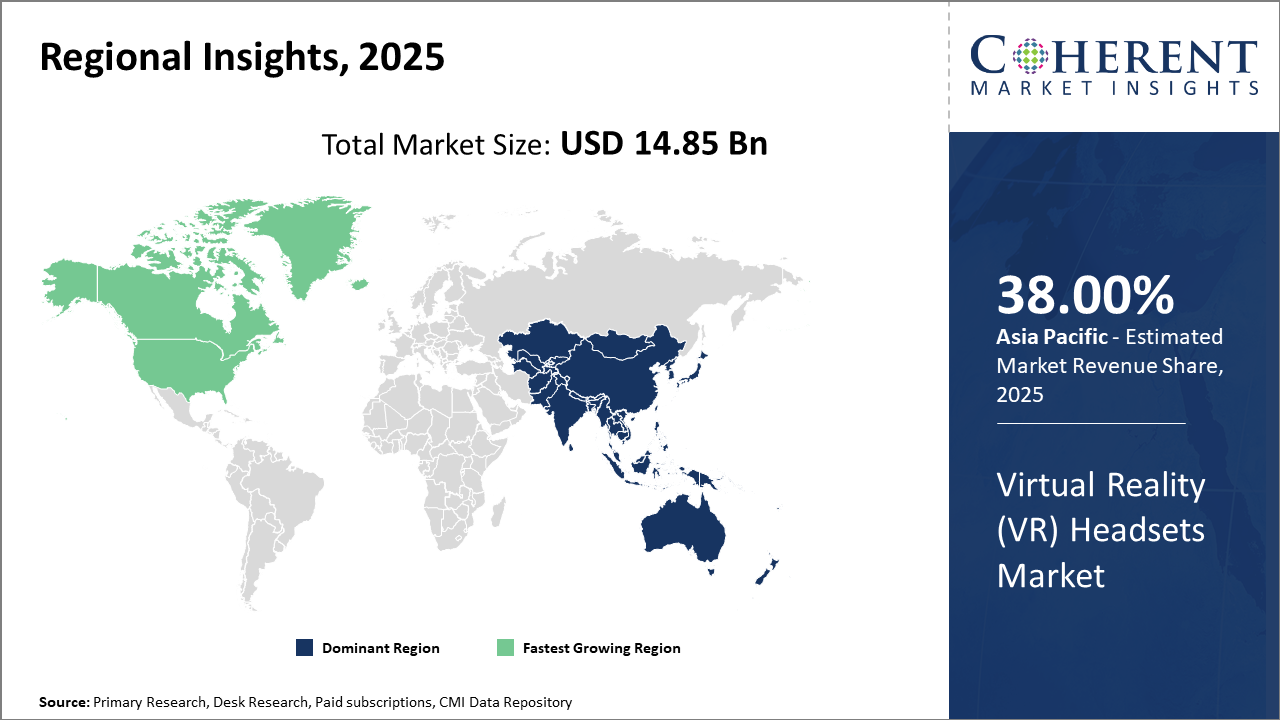Virtual Reality (VR) Headsets Market Size and Forecast – 2025 – 2032
The Global Virtual Reality (VR) Headsets Market size is estimated to be valued at USD 14.85 billion in 2025 and is expected to reach USD 43.72 billion by 2032, exhibiting a compound annual growth rate (CAGR) of 16.2% from 2025 to 2032.
Global Virtual Reality (VR) Headsets Market Overview
Virtual Reality (VR) headsets are immersive devices that simulate real or imagined environments through stereoscopic 3D visuals, motion tracking, and audio integration. These headsets use advanced sensors, lenses, and displays to create a fully interactive experience for users in gaming, education, healthcare, and industrial training applications. Available in tethered, standalone, and smartphone-based formats, VR headsets are powered by hardware components like gyroscopes, accelerometers, and eye-tracking sensors. Leading manufacturers continually enhance resolution, comfort, and field of view to improve realism and reduce motion sickness.
Key Takeaways
The tethered VR headset segment dominates market share, primarily due to superior performance in gaming applications, supported by high-fidelity visuals and processing capabilities.
Standalone VR headsets represent the fastest-growing subsegment, driven by enhanced portability and ease of use in enterprise training and education sectors.
Within component segments, displays hold the largest market revenue share attributable to continual improvements in resolution and refresh rate.
Regionally, Asia Pacific leads the Virtual Reality (VR) Headsets market share owing to its manufacturing stronghold and adoption rate, while North America exhibits the highest CAGR, fueled by enterprise investments and consumer readiness.
Virtual Reality (VR) Headsets Market Segmentation Analysis

To learn more about this report, Download Free Sample
Virtual Reality (VR) Headsets Market Insights, By Type
Tethered VR Headsets dominate the market share at 45%, due to their superior graphical performance and lower latency, making them the preferred choice for hardcore gamers and professional applications. The rapid evolution of tethered devices enhances business growth for high-end VR deployments. Standalone VR Headsets emerge as the fastest growing subsegment, propelled by increasing consumer demand for portability and ease of use without dependency on external hardware.
Virtual Reality (VR) Headsets Market Insights, By Application
Gaming leads the market share due to its early adoption and continuous influx of advanced interactive content, driving significant market revenue. Enterprise & Training applications register the fastest growth, fueled by the adoption of VR for remote collaboration, skill development, and virtual prototyping across industries, particularly in North America. Healthcare & Medical applications leverage VR headsets for surgical training and therapy, gaining steady traction
Virtual Reality (VR) Headsets Market Insights, By Component
Displays command the largest market revenue, driven by innovations in high-resolution OLED and microLED panels, improving visual fidelity and user comfort. Processors & GPUs are critical for rendering complex VR environments, experiencing rapid upgrades to support AI-enhanced graphics. Sensors & Cameras enhance spatial awareness and motion tracking, vital for immersive experience, and continue to show considerable investment and rapid evolution.
Virtual Reality (VR) Headsets Market Trends
The Virtual Reality (VR) Headsets market continues to experience accelerated innovation driven by consumer demand for richer, untethered experiences.
Hybrid solutions blending VR with augmented reality capabilities are emerging as industry disruptors, allowing seamless transitions between virtual and real environments.
For example, integration of AI-powered hand-tracking technology in standalone headsets has improved user precision and reduced peripheral device dependency in 2024.
Furthermore, increasing investments in content development, particularly in education and training, have amplified market scope beyond entertainment.
Notably, subscription and cloud streaming models have gained traction, allowing users flexible access while manufacturers collect recurring revenues, reflecting a transformative shift in market dynamics.
Virtual Reality (VR) Headsets Market Insights, By Geography

To learn more about this report, Download Free Sample
Asia Pacific Virtual Reality (VR) Headsets Market Analysis and Trends
In the Asia Pacific region, the dominance in the Virtual Reality (VR) Headsets market is supported by robust manufacturing ecosystems, especially in China and Taiwan, which together contribute approximately 38% of the global virtual reality (VR) headsets market share. Government incentives encouraging technology exports and investments into semiconductor fabs have accelerated innovation cycles. Furthermore, rising consumer tech savvy and expanding content ecosystems in countries like Japan and South Korea amplify regional market growth.
North America Virtual Reality (VR) Headsets Market Analysis and Trends
North America exhibits the fastest growth with a CAGR upwards of 17%, propelled by extensive enterprise adoption, particularly in the U.S.-based education and healthcare sectors. Advanced infrastructure, high per capita tech expenditure, and investments from leading companies such as Meta and Microsoft underpin the robust growth trajectory. Favorable regulatory frameworks and rapid incorporation of VR in corporate training programs have further stimulated demand.
Virtual Reality (VR) Headsets Market Outlook for Key Countries
USA Virtual Reality (VR) Headsets Market Analysis and Trends
The U.S. market remains the cornerstone of innovation and adoption in the Virtual Reality (VR) Headsets sector. In 2024, the U.S. reported over 30% of the worldwide VR headset revenue, driven by substantial investments from technology giants and a burgeoning startup ecosystem. Strategic collaborations between hardware producers and software developers have created a comprehensive VR ecosystem supporting enterprise and consumer applications. Moreover, government initiatives promoting digital and virtual innovations, particularly in education and defense, bolster further business growth.
China Virtual Reality (VR) Headsets Market Analysis and Trends
China’s Virtual Reality (VR) Headsets market benefits from its comprehensive supply chain dominance and large-scale manufacturing capabilities, making it a global export hub. The Chinese government’s focus on advancing “smart” technology industries has provided funding to local VR companies, enhancing R&D facilities and patent portfolios. Rapid urbanization paired with increasing consumer income levels supports strong domestic demand, particularly in the gaming and education sectors. Leading Chinese companies, such as DPVR and Pico Interactive, aggressively invest in tech advancement and international market expansion, thus reinforcing China’s significant role in the global market.
Analyst Opinion
Increased production capacity and component innovation have played a pivotal role in driving market revenue. For instance, the ramp-up in OLED and micro-LED display manufacturing has decreased costs by nearly 12% in 2024, enabling broader accessibility of mid-range VR headsets. Supply chain optimizations in key manufacturing hubs like Taiwan and South Korea have strengthened production throughput by 15%, resulting in greater market availability.
Demand-side shifts demonstrate a strong surge in VR headset adoption in corporate training and telepresence applications. In 2025, over 40% of enterprise VR deployments worldwide are projected to concentrate on employee upskilling and remote collaboration platforms, supporting market growth strategies focused on B2B segments. This diversification beyond gaming has expanded market scope significantly.
Advanced pricing strategies introduced in late 2024—such as subscription or usage-based models—have boosted user acquisition rates by 18%, notably in North America and Europe. Pricing flexibility combined with enhanced device performance has accelerated the penetration in the education and healthcare sectors, with institutions adopting VR solutions for immersive simulations.
Regional import-export data from 2025 reveals that the Asia Pacific region remains the largest VR headset market by volume, accounting for roughly 38% market share, with China leading production. Cross-border trade agreements have eased tariff barriers, facilitating increased exports to Europe and the Middle East. Concurrently, consumer preference for lightweight and standalone headsets is shaping product evolution.
Market Scope
| Report Coverage | Details | ||
|---|---|---|---|
| Base Year: | 2025 | Market Size in 2025: | USD 14.85 billion |
| Historical Data for: | 2020 To 2024 | Forecast Period: | 2025 To 2032 |
| Forecast Period 2025 to 2032 CAGR: | 16.2% | 2032 Value Projection: | USD 43.72 billion |
| Geographies covered: |
|
||
| Segments covered: |
|
||
| Companies covered: | Meta Platforms, Sony Corporation, HTC Corporation, Samsung Electronics, Valve Corporation, Panasonic Corporation, Pico Interactive, Google LLC, Microsoft Corporation, Lenovo Group, Vuzix Corporation, Epson, DPVR, Oculus VR (subsidiary of Meta), Pico Neo, Varjo Technologies, DPVR, and SK Telecom. | ||
| Growth Drivers: |
|
||
Uncover macros and micros vetted on 75+ parameters: Get instant access to report
Virtual Reality (VR) Headsets Market Growth Factors
The rapid technological development in display resolution and field of view delivers increasingly realistic user experiences, a primary market driver witnessed in 2024 when headset resolutions surpassed 4K per eye, significantly boosting user engagement metrics. Expansion of VR use cases beyond gaming—such as virtual classrooms and surgical simulation—has diversified market demand, with enterprise VR adoption growing by 35% in 2025. Enhanced affordability and accessibility, driven by lower hardware costs and wider retail distribution, continue to propel consumer market penetration, exemplified by a 20% rise in standalone headset shipments. Lastly, supportive government initiatives promoting digital innovation, especially in the Asia Pacific, including grants and subsidies for VR startups, provide a conducive environment for sustained market growth.
Virtual Reality (VR) Headsets Market Development
In October 2025, Samsung unveiled Android XR headset, Galaxy XR (formerly Project Moohan), in South Korea. The device will run on a Snapdragon XR2 Plus Gen 2 chip, weigh under 500 g, and is projected to be priced at around USD 2,000—making it lighter and more affordable than Apple’s Vision Pro.
In March 2025, ProTubeVR confirmed that Valve unveiled a new VR headset, reinforcing earlier rumors about the upcoming device. Unlike other speculation and leaks, this information comes directly from an accessory manufacturer, adding credibility.
Key Players
Leading companies include:
Sony Corporation
HTC Corporation
Samsung Electronics
Valve Corporation
Panasonic Corporation
Pico Interactive
Google LLC
Microsoft Corporation
Lenovo Group
Vuzix Corporation
Epson
DPVR
Oculus VR (subsidiary of Meta)
Pico Neo
Varjo Technologies
DPVR
SK Telecom
Among these, Meta Platforms continues to leverage aggressive R&D investments and strategic content partnerships, driving substantial market share gains through its Quest series. Sony's PlayStation VR 2 launch in 2024 witnessed a 25% year-over-year revenue increase, capitalizing on a massive gaming install base. HTC’s Vive Pro ecosystem expands enterprise solutions, while Lenovo's focus on mixed-reality integrations supports entry into professional training segments.
Virtual Reality (VR) Headsets Market Future Outlook
Future growth will be shaped by the broader integration of VR into industrial design, retail, healthcare, and corporate training applications. The convergence of VR with augmented reality (AR) and mixed reality (MR) technologies will redefine immersive ecosystems. Advancements in 5G connectivity, eye-tracking, and haptic feedback will enhance realism and reduce latency, while declining component costs will make headsets more affordable for consumers. Partnerships between hardware developers, software studios, and content creators will continue to expand applications beyond gaming into enterprise-grade solutions.
Virtual Reality (VR) Headsets Market Historical Analysis
The virtual reality headset market emerged from experimental simulation technologies in the 1990s to consumer-ready devices in the mid-2010s, following advances in graphics processing, motion tracking, and display resolution. Early products like Oculus Rift and HTC Vive brought VR into mainstream gaming and entertainment, while declining hardware costs encouraged adoption across training, healthcare, and education. The pandemic years accelerated interest in immersive technologies as companies sought remote collaboration tools and virtual experiences. Over time, innovation shifted from tethered systems to lightweight standalone devices, improving comfort and accessibility.
Sources
Primary Research interviews:
VR Hardware Engineers
Game Developers
Consumer Electronics Retailers
AR/VR Content Producers
Databases:
IDC Worldwide Quarterly AR/VR Headset Tracker
Magazines:
VRScout
TechRadar
VentureBeat (AR/VR)
Journals:
Computers & Graphics
Virtual Reality Journal
IEEE Transactions on Visualization and Computer Graphics
Frontiers in Virtual Reality
Newspapers:
The Times of India (Technology)
The Guardian (Science)
The New York Times (Tech)
Financial Times (Consumer Electronics)
Associations:
Virtual Reality Society
International VR/AR Association (IVRA)
Khronos Group (VR Standards)
Consumer Technology Association (CTA)
Share
Share
About Author
As an accomplished Senior Consultant with 7+ years of experience, Pooja Tayade has a proven track record in devising and implementing data and strategy consulting across various industries. She specializes in market research, competitive analysis, primary insights, and market estimation. She excels in strategic advisory, delivering data-driven insights to help clients navigate market complexities, optimize entry strategies, and achieve sustainable growth.
Missing comfort of reading report in your local language? Find your preferred language :
Transform your Strategy with Exclusive Trending Reports :
Frequently Asked Questions
Select a License Type
Joining thousands of companies around the world committed to making the Excellent Business Solutions.
View All Our Clients